Excerpts from Jim Conrad's
Naturalist Newsletter
entry dated April 28, 2022, issued from near Tequisquiapan, elevation about 1,900m (6200 ft), ~N20.57°, ~ W99.89°, Querétaro state, MÉXICO
NAKEDWOOD FLOWERING

Now during the driest part of the late dry season, on the floor of a shallow little arroyo relatively lush with green vegetation -- partly because every couple of weeks water overflows from irrigated alfalfa fields upstream, muddying the whole arroyo -- the above dry-season-leafless bush or small tree is flowering. On the picture's left side, that's leafed-out Smooth Mesquite, and on the left, flowering Whitebrush. A branch showing the new growth on naked stems is shown below:

Each cluster of new growth consists of several flowers and emerging leaves:
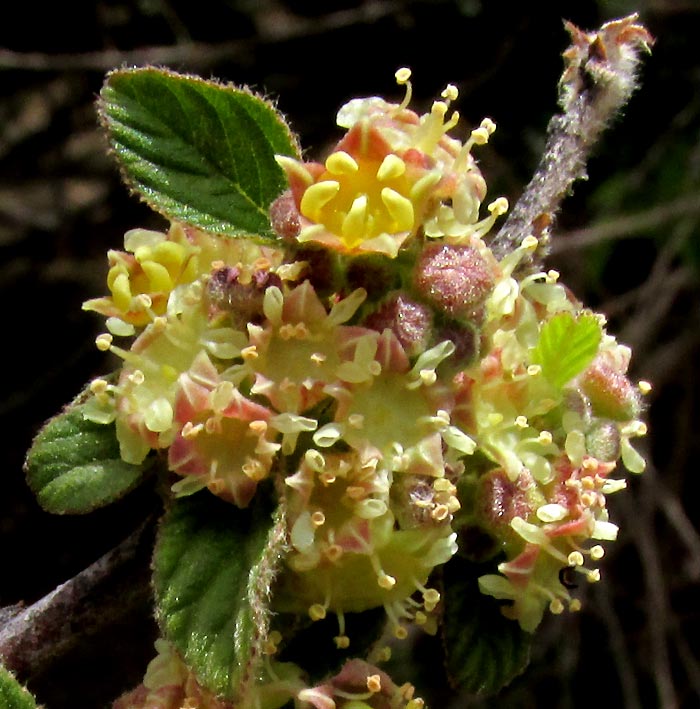
At this distance already the distinct flower structure indicates the Buckthorn Family, the Rhamnaceae, mostly a family of the world's tropical and subtropical regions. Notice that each flower's small, white, scoop-shaped petals and stamens are mounted on the side of the pinkish calyx, not at the base of the ovary. The lower part of the calyx forms an hypanthium of the kind you can also see in rose flowers. During the identification process it'll also be important to notice that the stamens are about the same length as the petals, not longer.
The most striking feature, however, is that covering each flower's bottom, from petal base to petal base, is a pale yellow, somewhat fleshy- or waxy-looking disk-like expanse, which is a nectary. Nectaries are small secretory structures typically found at the base of stamens. They provide food rewards to insect and bird pollinators, and Rhamnaceae has impressive ones. Below is a closer look:
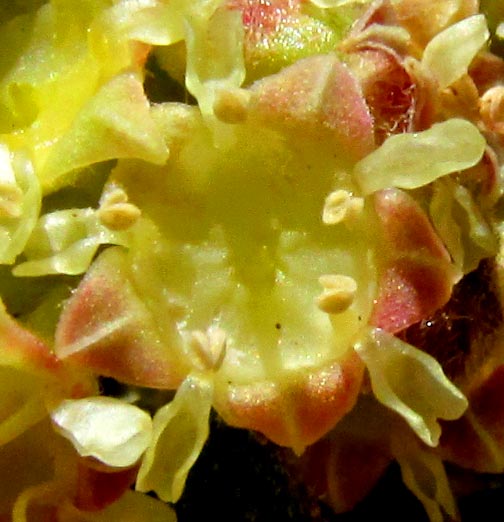
The fact that the stamens arise next to the scoop-shaped petals, not between them as in many flowers, also a feature of the Buckthorn Family.
Though the leaves are just emerging, already we can see features of venation and leaf margin, which turn out to be important for this ID, as shown below:
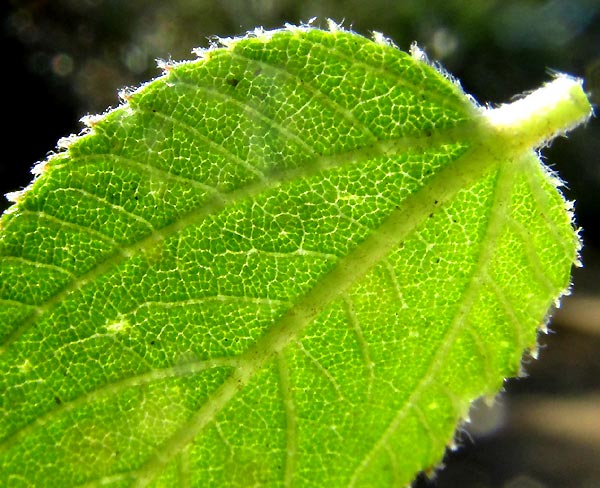
All these field marks and others lead us to COLUBRINA MACROCARPA, which has no English name of its own, since it's endemic just to Mexico. However, some Colubrina species are native to the US, and collectively they're known as nakedwoods. In Mexico this species occurs in the central and southern regions. Identification was made possible mostly by the 2010 work of Rafael Fernández Nava, freely available on the internet, entitled "Nombres comunes, etnobotánica y distribución geográfica del género Colubrina (Rhamnaceae) en México."
In that publication it's reported that the species has been used in traditional Mexican medicine to treat cancer and gastric ulcers, and in fact lab tests have demonstrated cytotoxic effects. Otherwise, local people use it as firewood.
entry dated December 30, 2022, issued from near Tequisquiapan, elevation about 1,900m (6200 ft), ~N20.57°, ~ W99.89°, Querétaro state, MÉXICO
NAKEDWOOD WITH MATURE FRUITS
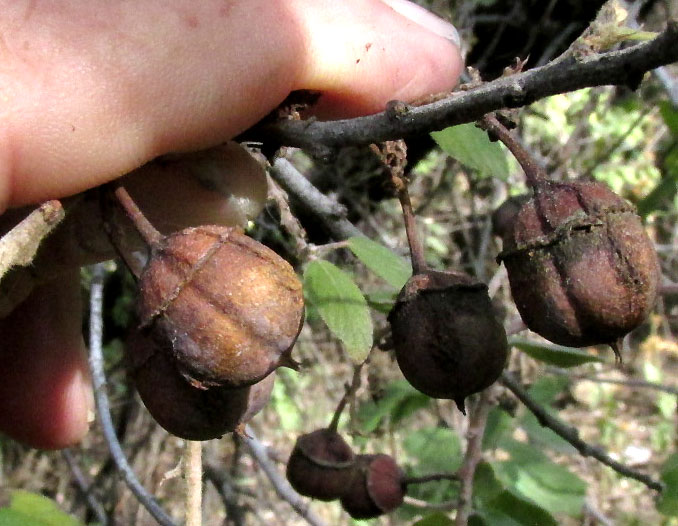
In the same shallow little arroyo in which the above photos were taken, nowadays Colubrina macrocarpa trees are conspicuously loaded with capsular fruits, shown above. The fruits appeared around July or so, but remained green until about a month ago. Though the fruits are described as capsular, the ones above showed no sign of splitting open to release their seeds. The Flora del Bajío says that the fruits can persist for a year or more without opening. The Flora of North America describes flowers of the genus Colubrina as producing an "ovary 1/2-inferior to inferior." Fruits in the above picture show the results of that, with what appears to be broad, brown bowl-like structures attached to the stems, with brown capsules emerging from the bowls. The bowls are what became of the hypanthia covering about a quarter of the ovaries.The following picture shows that hardly any flesh covers the wood-hard seeds:
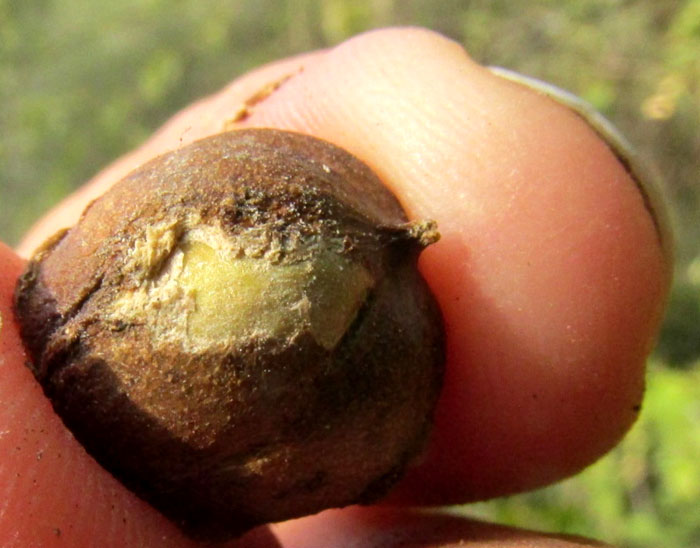
In the above picture, the finger provides scale for judging the fruit's size. My finger at the part where the fruit is held is 18mm wide. An important field mark distinguishing this species -- with its species name of macrocarpa meaning "big fruit" -- is the fruit's relatively large size.
In 2001 a presentation at a congress held in Varacruz, Veracruz, focusing on biotechnology and plant bioengineering, was given by Jovita Popoca and others, entitled "Actividad citotóxica de Colubrina macrocarpa (Cav) Don. Rhamnaceae propagada in vitro." In that presentation the authors asserted that the vegetative parts of Colubrina macrocarpa, particularly the roots, have long been used in Mexican traditional medicine, often known as árnica de raiz roja, to treat cancer. The roots have been in such demand for such treatments that the species' numbers have been much reduced. The authors' studies confirmed that extracts of roots, stems and leaves demonstrated significant cytotoxic effects. Cytotoxic drugs are those containing chemicals which are toxic to cells, preventing their replication or growth, and so are used to treat cancer, as well as disorders such as rheumatoid arthritis and multiple sclerosis. Of the various cancer cell lines tested, the extract was most effective against the ovarian cancer cell line (OVCAR).